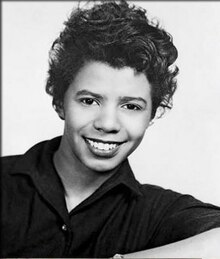Lorraine Hansberry | |
|---|---|
 Hansberry in 1955 | |
| Born | Lorraine Vivian Hansberry May 19, 1930 Chicago, Illinois, U.S. |
| Died | January 12, 1965 (aged 34) New York City, U.S. |
| Nationality | American |
| Education | University of Wisconsin–Madison The New School |
| Occupation(s) | Playwright, writer, stage director |
| Notable work | A Raisin in the Sun |
| Spouse | |
Lorraine Vivian Hansberry (May 19, 1930 – January 12, 1965) was an American playwright and writer.[1] She was the first African-American female author to have a play performed on Broadway. Her best-known work, the play A Raisin in the Sun, highlights the lives of black Americans in Chicago living under racial segregation. The title of the play was taken from the poem "Harlem" by Langston Hughes: "What happens to a dream deferred? Does it dry up like a raisin in the sun?" At the age of 29, she won the New York Drama Critics' Circle Award — making her the first African-American dramatist, the fifth woman, and the youngest playwright to do so.[2] Hansberry's family had struggled against segregation, challenging a restrictive covenant in the 1940 U.S. Supreme Court case Hansberry v. Lee.
After she moved to New York City, Hansberry worked at the Pan-Africanist newspaper Freedom, where she worked with other black intellectuals such as Paul Robeson and W. E. B. Du Bois. Much of her work during this time concerned the African struggles for liberation and their impact on the world. Hansberry also wrote about being a lesbian and the oppression of gay people.[3][4] She died of pancreatic cancer at the age of 34 during the Broadway run of her play The Sign in Sidney Brustein's Window in 1965.[5] Hansberry inspired the Nina Simone song "To Be Young, Gifted and Black", whose title-line came from Hansberry's autobiographical play.
- ^ Lipari, Lisbeth. "Queering the borders: Lorraine Hansberry's 1957 Letters to The Ladder" Paper presented at the annual meeting of the International Communication Association, Marriott Hotel, San Diego, CA, May 27, 2003 Archived April 5, 2020, at the Wayback Machine. Online. June 28, 2008.
- ^ Cheney, Anne, Lorraine Hansberry (Boston: Twayne, 1984). Regenstein Bookstacks, PS3515.A595Z8C51.
- ^ Anderson, Melissa (February 26, 2014). "Lorraine Hansberry's Letters Reveal the Playwright's Private Struggle". The Village Voice.
- ^ Belletto S (2017). American Literature in Transition, 1950–1960. Cambridge University Press. p. 176. ISBN 978-1108307819.
- ^ Markel H (2019). Literatim: Essays at the Intersections of Medicine and Culture. Oxford University Press. p. 194. ISBN 978-0190070014.